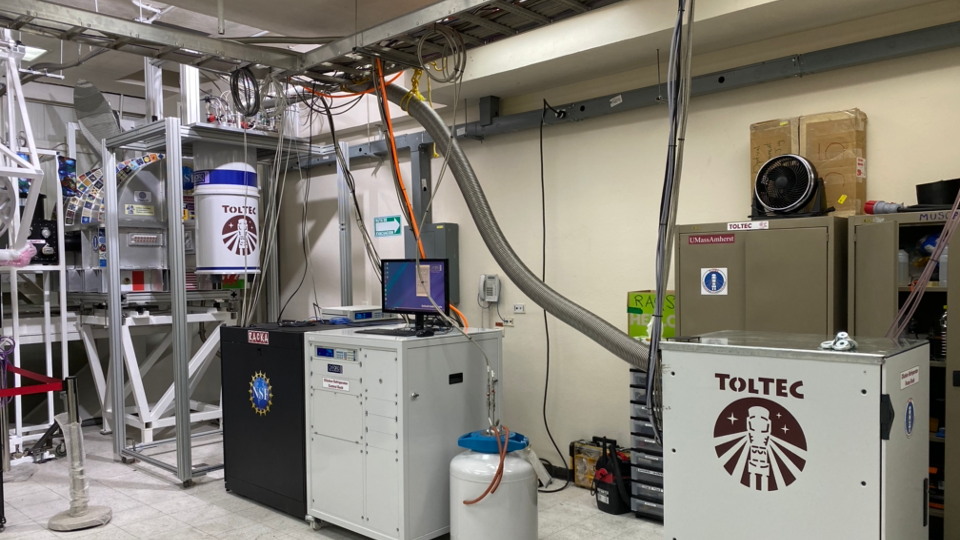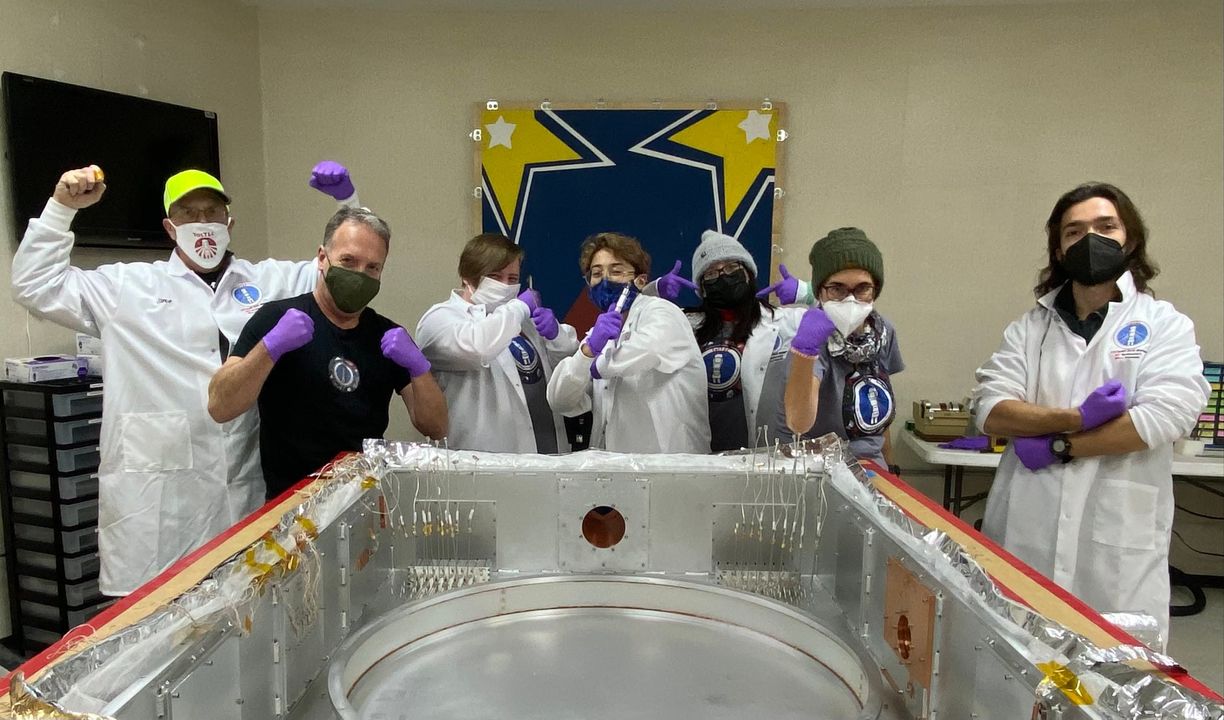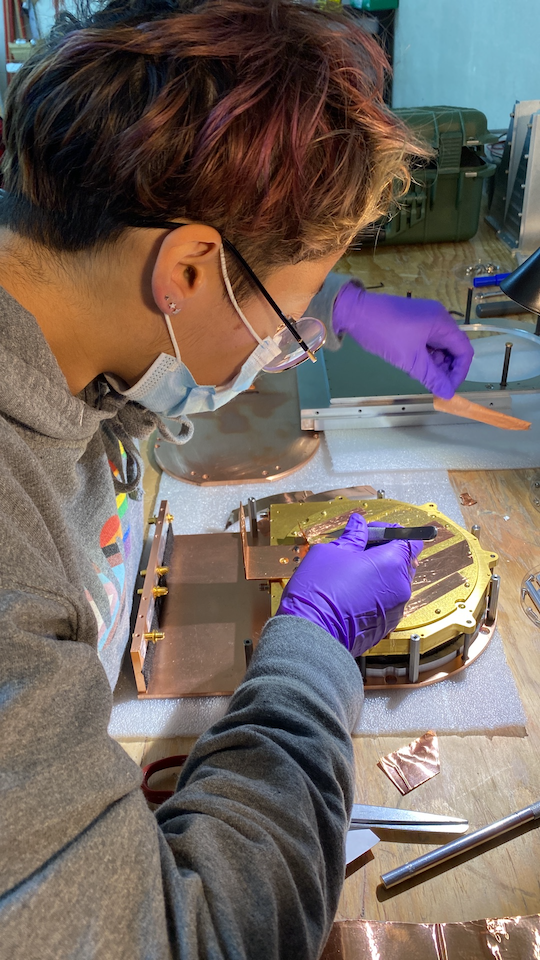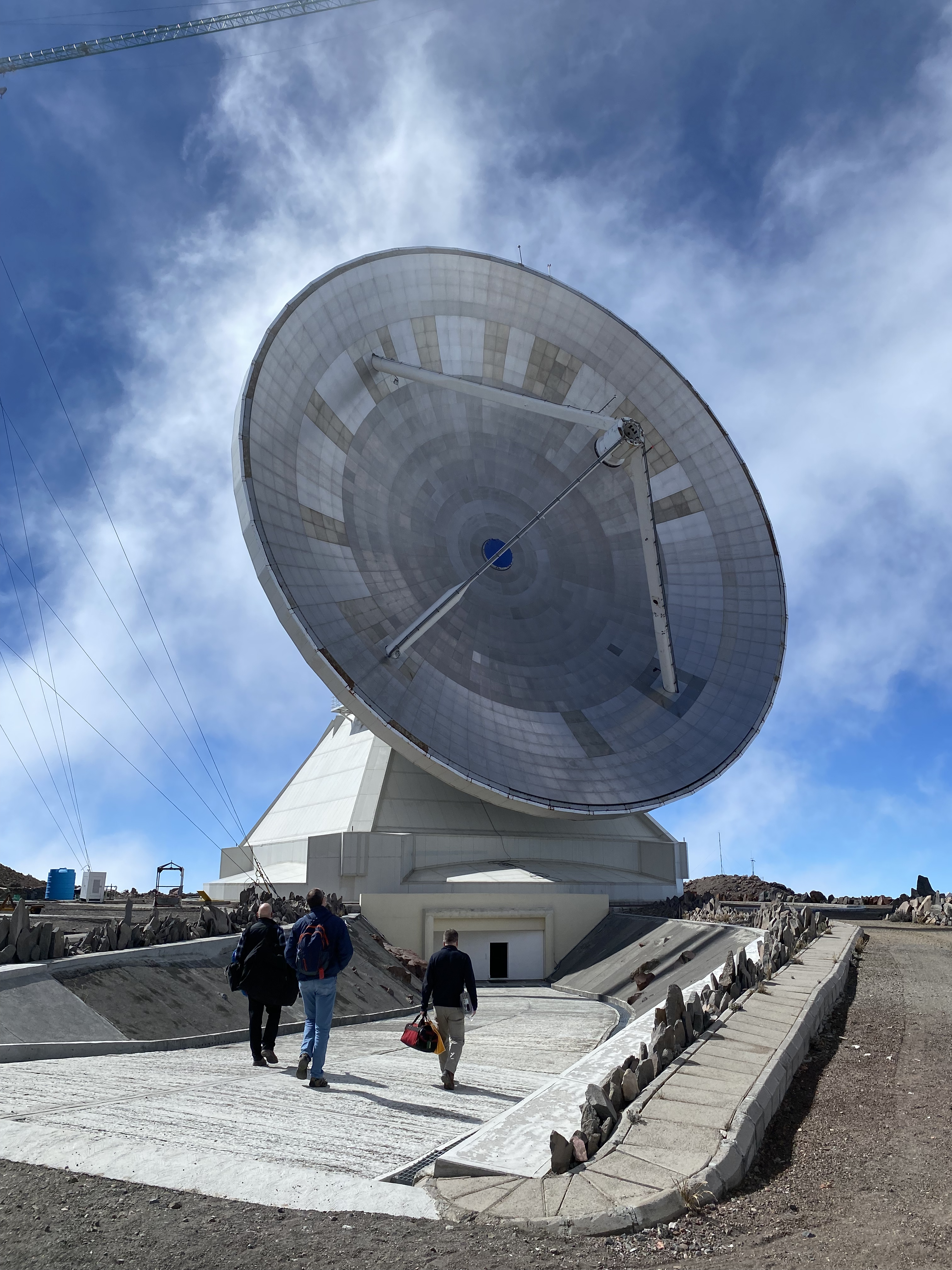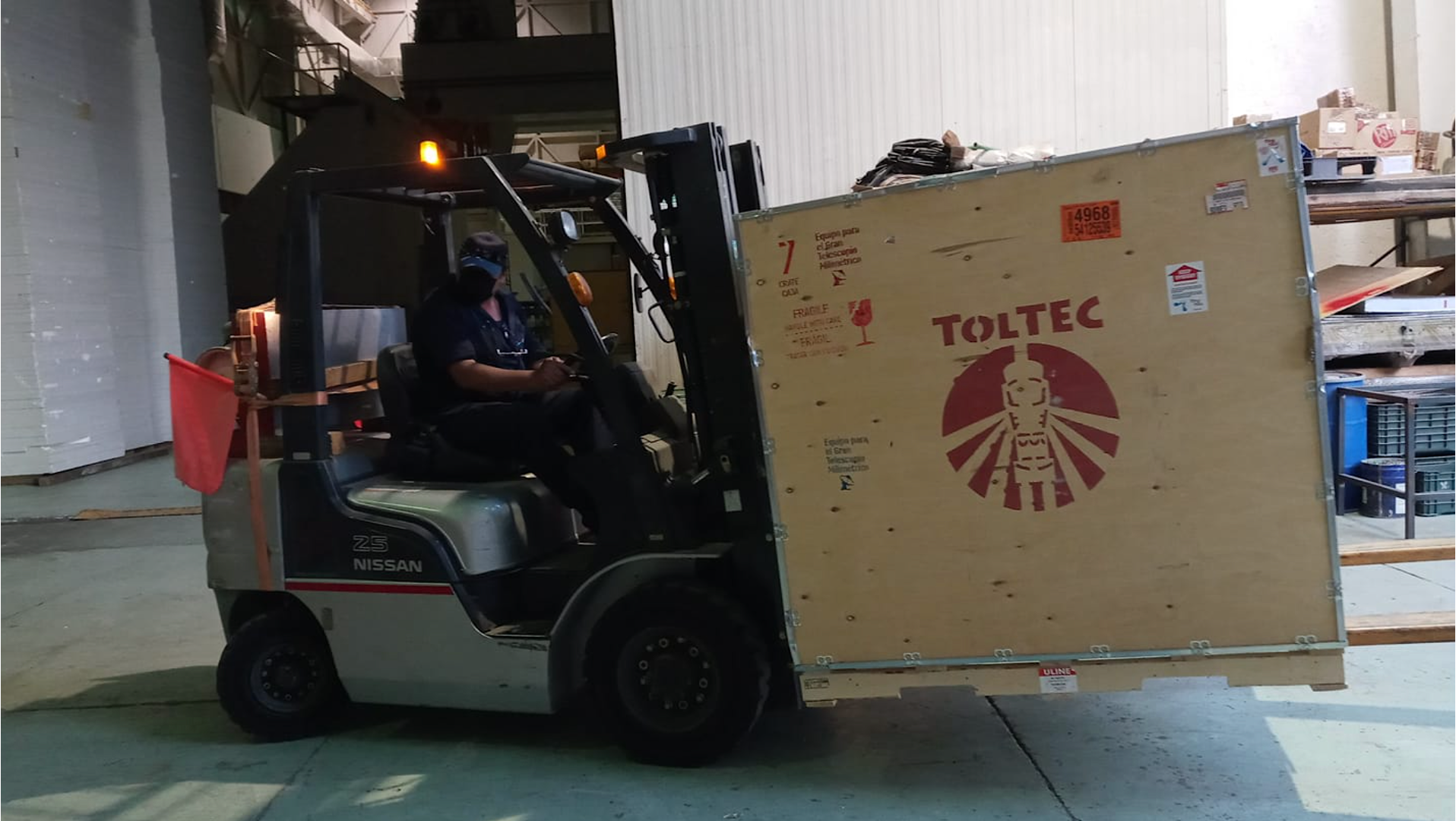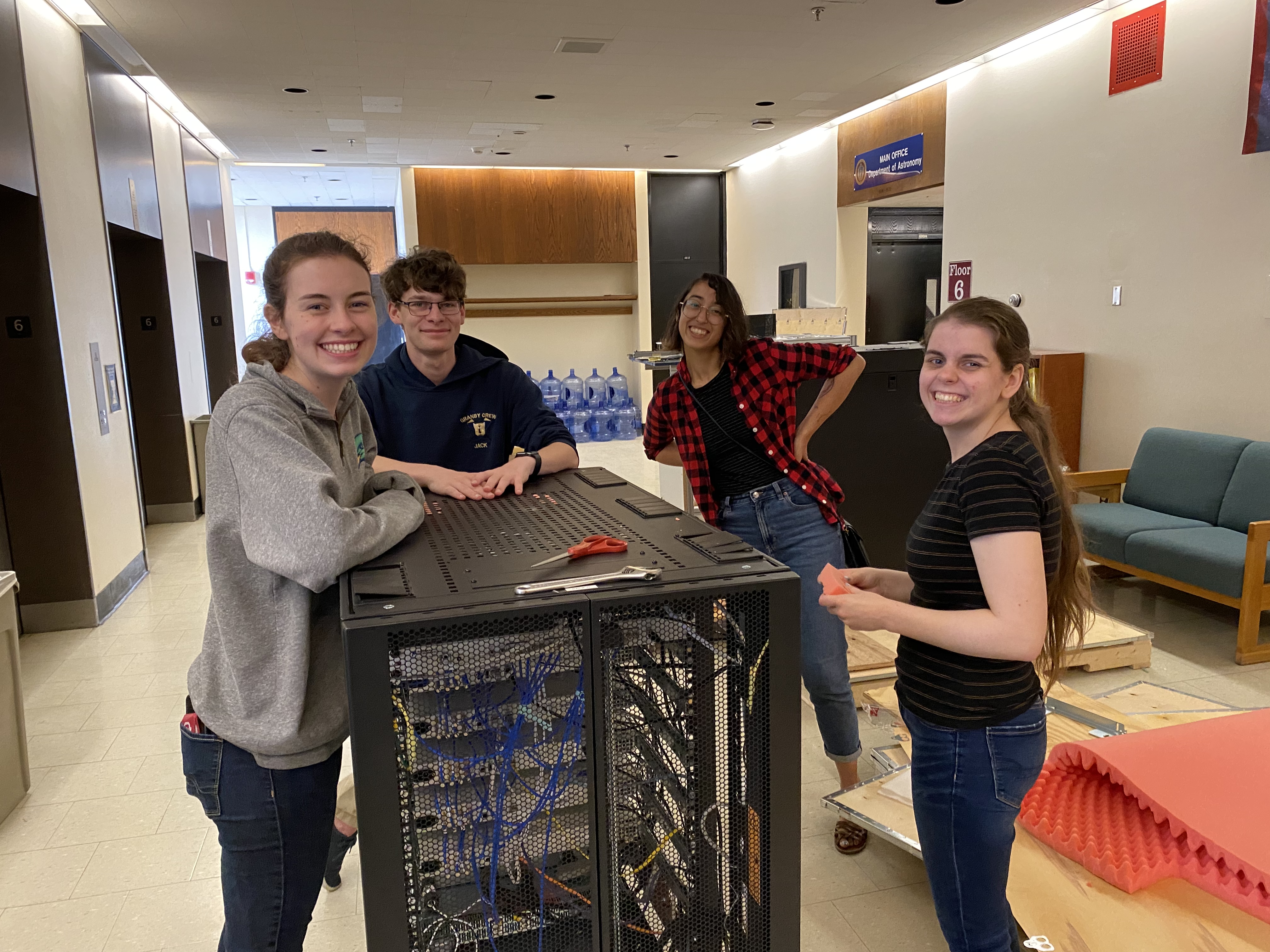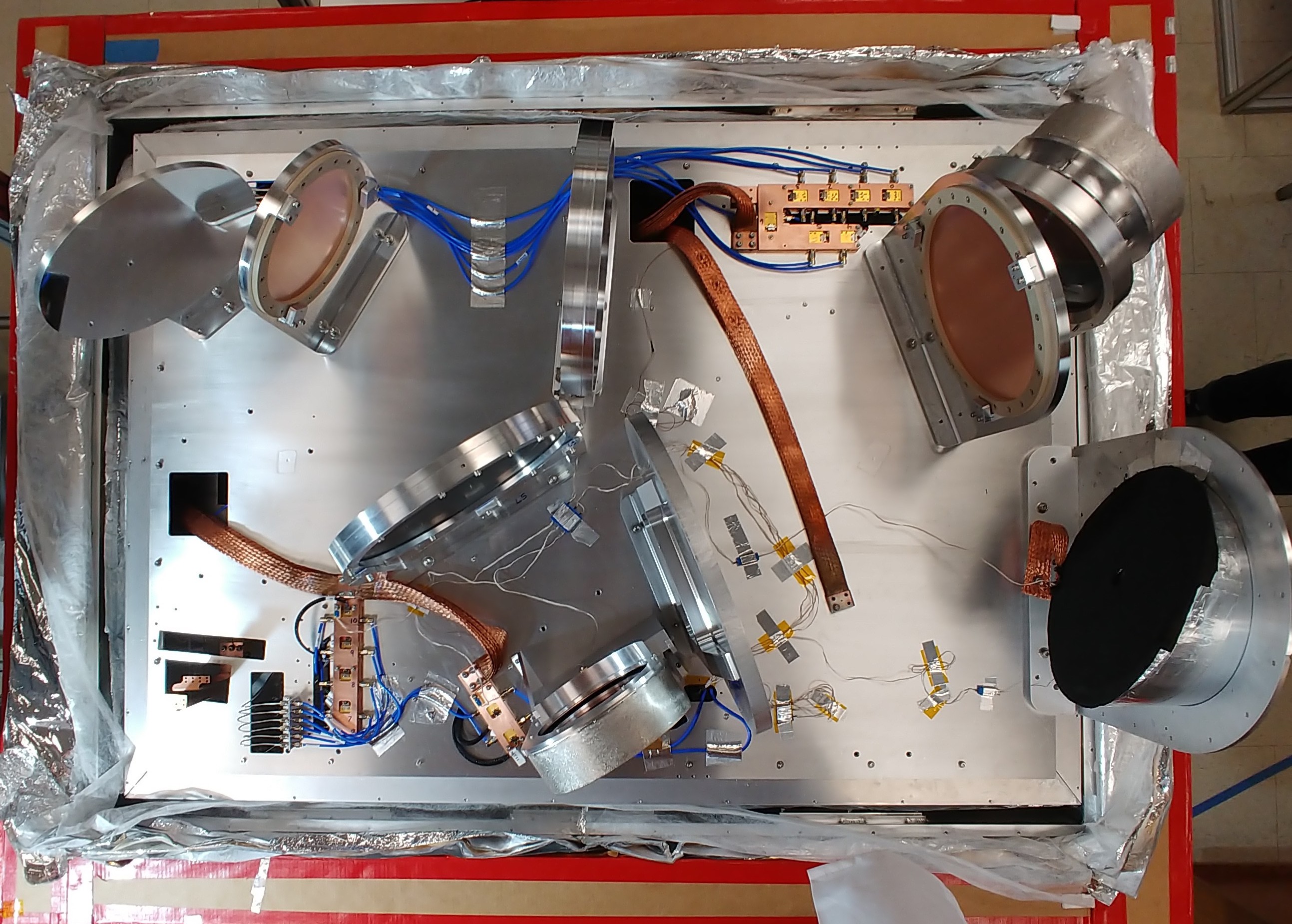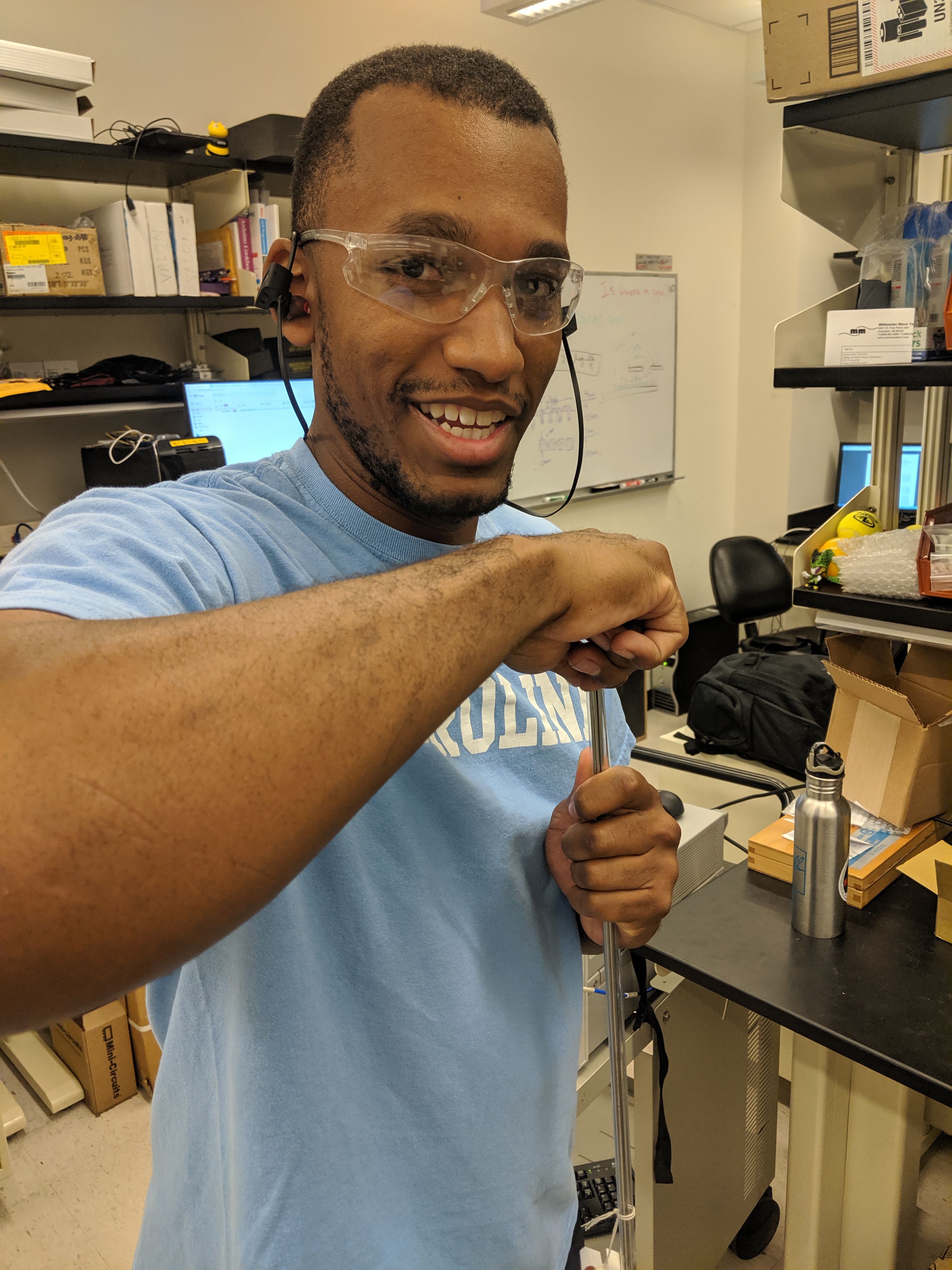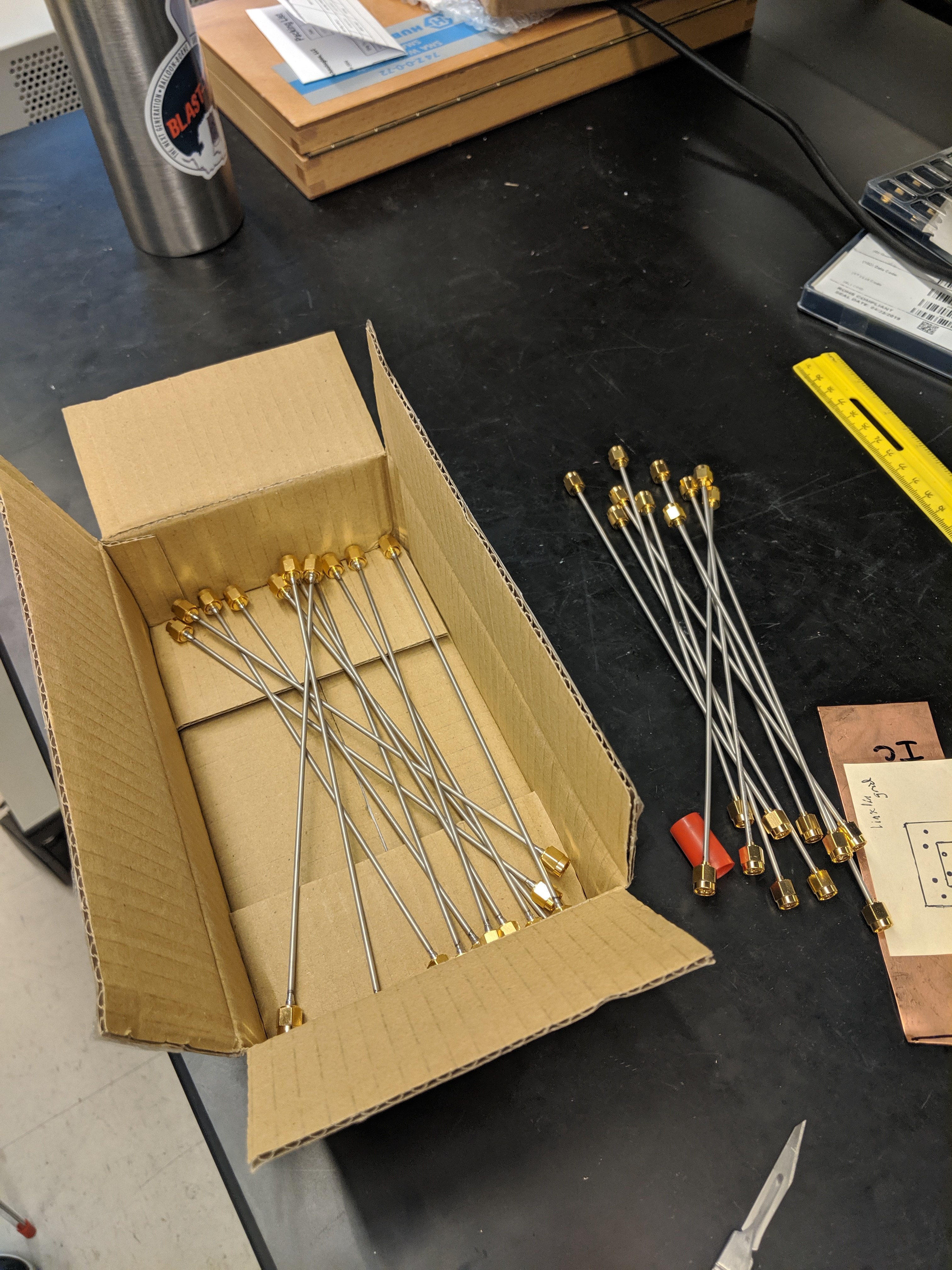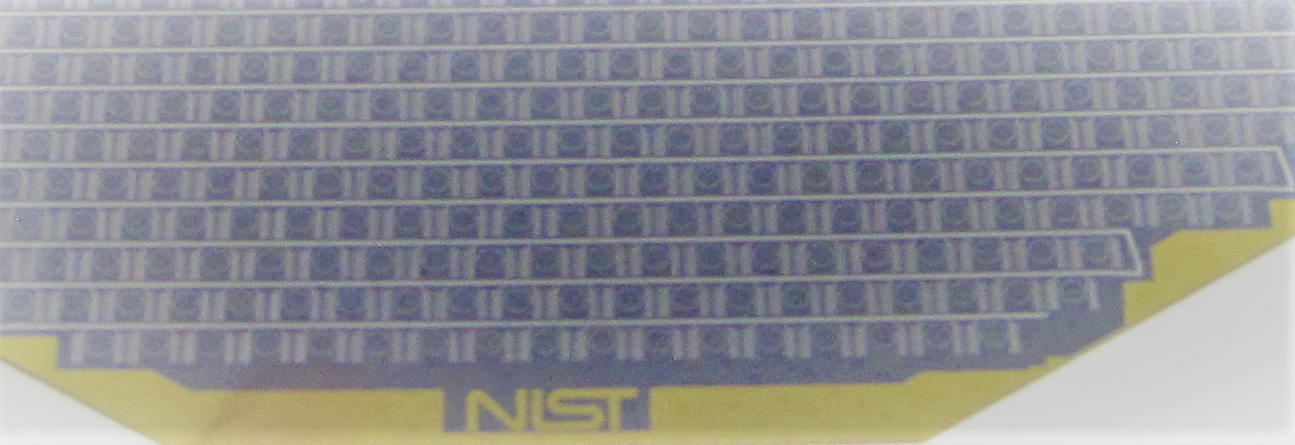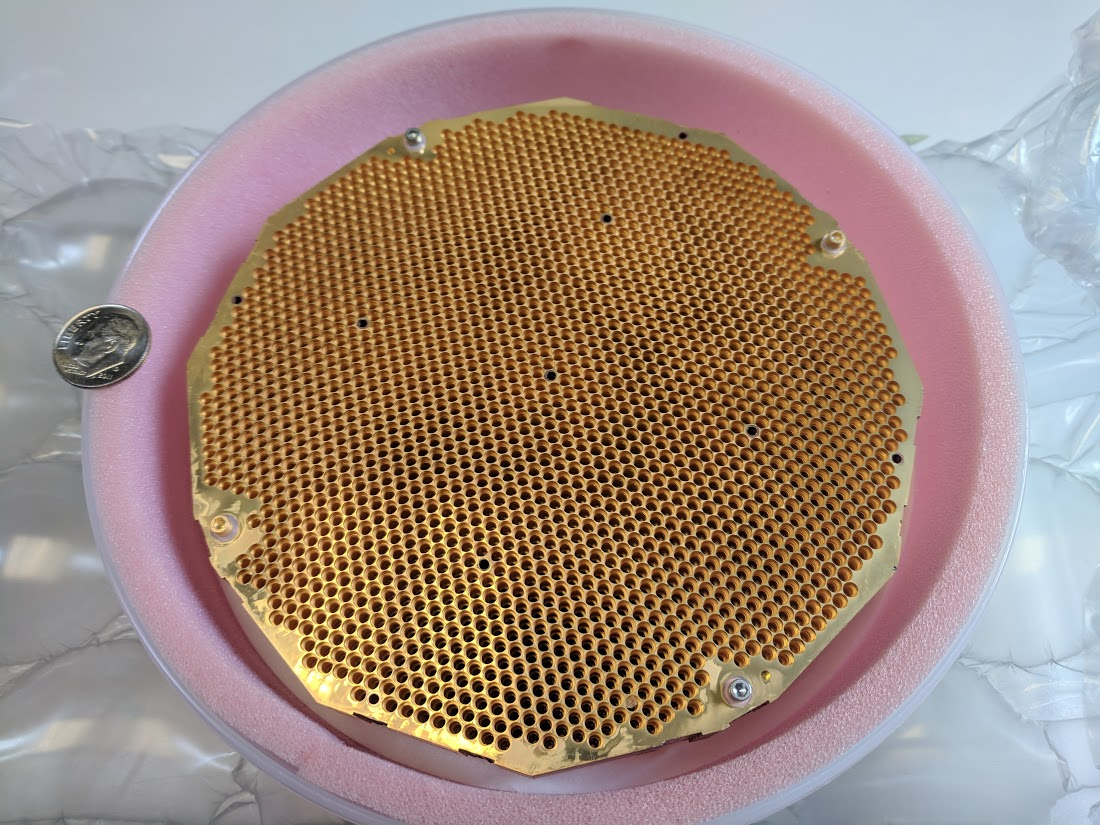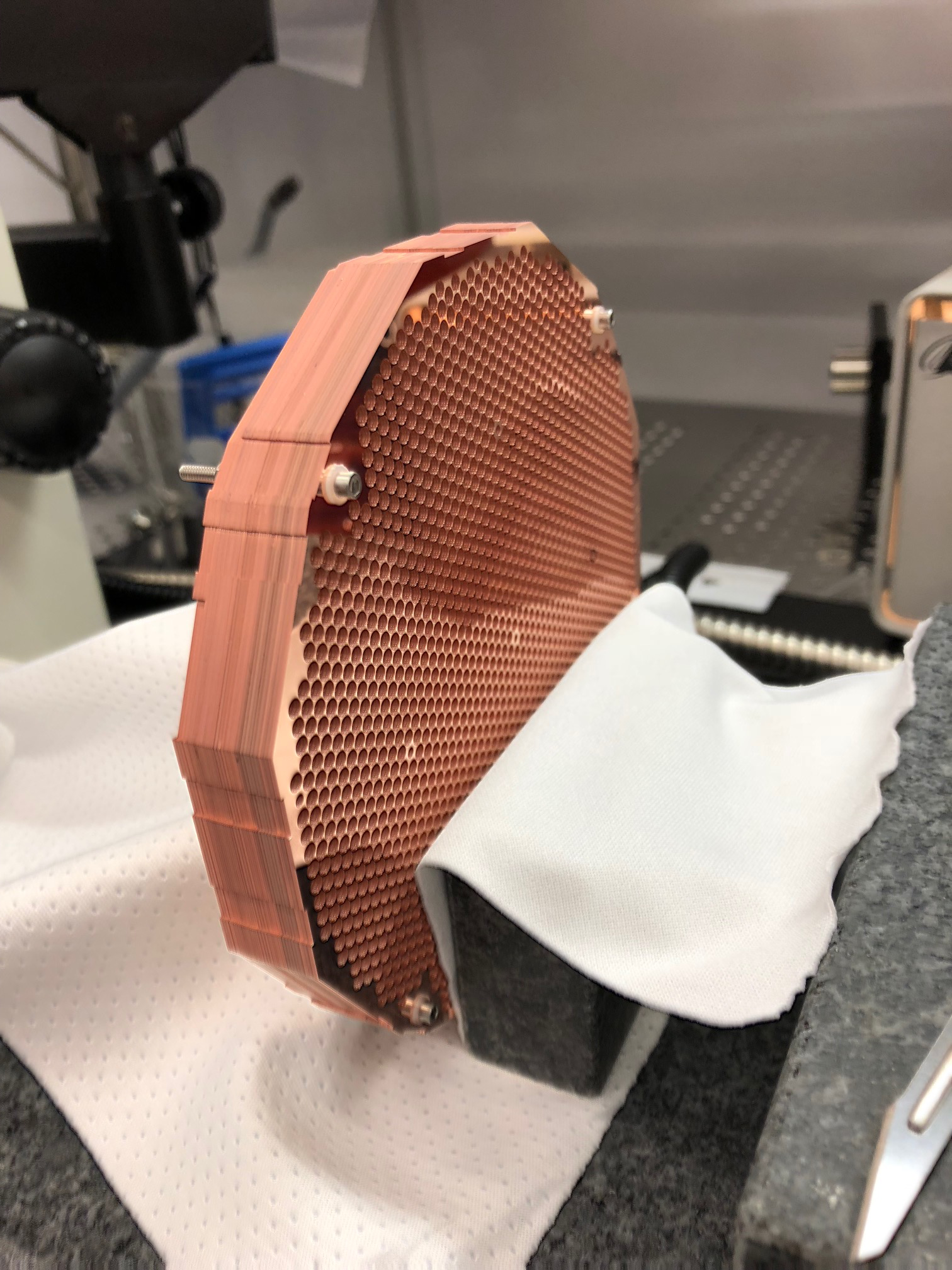News
February 5, 2024 This is two pieces of great news in one week. TolTEC graduate student Joey Golec, at the University of Chicago, has been awarded a prestigious NSF Astronomy and Astrophysics Postdoctoral Fellowship. These are extremely competitive fellowships and it is a testament to Joey's hard work and innovation in data analysis and mapmaking. Joey will be taking his AAPF to UMass to work on galaxy cluster studies with TolTEC. Congratulations Joey!
February 2, 2024 We are happy to report that one of our key team members, Michael McCrackan, who is planning on defending his PhD dissertation this spring, has just accepted a postdoctoral position at Yale University. Michael will be bringing his tremendous software and data analysis skills to the Yale Physics department to work with Dr. Laura Newburgh on the Advanced Simons Observatory. Congratulations Michael!
For those keeping track (and I am), former TolTEC students are now either students or postdocs at places like Harvard, the University of Chicago, NASA/Goddard Space Flight Center, Johns Hopkins, and Cornell University. It's exciting to add Yale to this list. We are very proud of the focus on education and career advancement that we've had and will continue to pursue in our team.
December 14, 2023 The winter solstice is almost here and what better way to brighten our collective moods than to reveal some TolTEC imaging and polarimetry results publicly for the first time. Though the telescope remains without power and is projected to do so until the new year, our mapmaking and polarimetry groups continue to work hard to build our best estimates of the astronomical sky at millimeter wavelengths. This is technically difficult work and we are so proud of the results that are coming out. Here is a sampling of two different types of analyses.
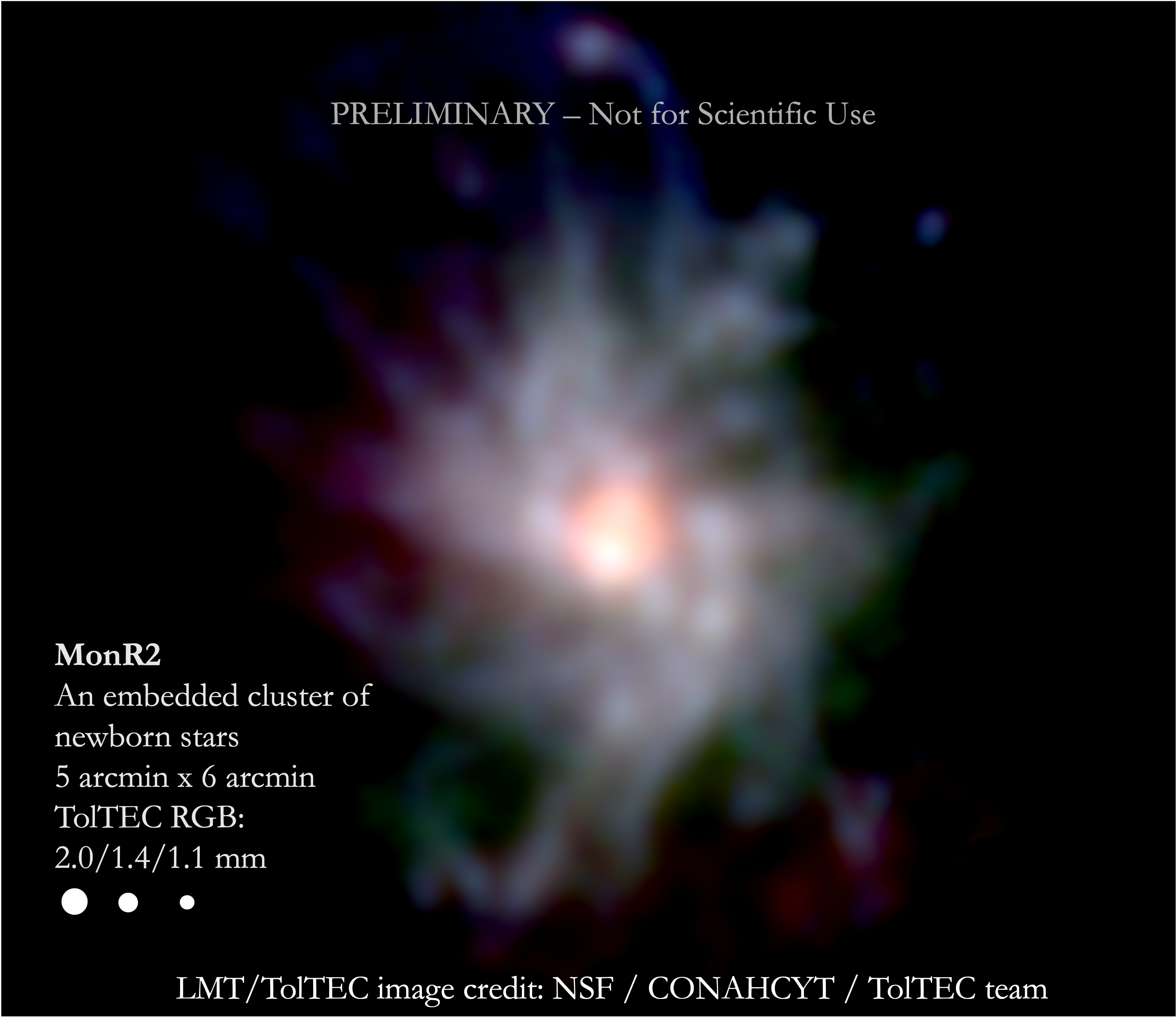
Our second new result comes from the Minkasi maximum likelihood mapmaker where our team has analyzed both the total power signal and the polarization state of the emission. We show the result here for the 2.0mm band. The vectors here are only meant to indicate the angle of the polarized emission, not the amplitude.
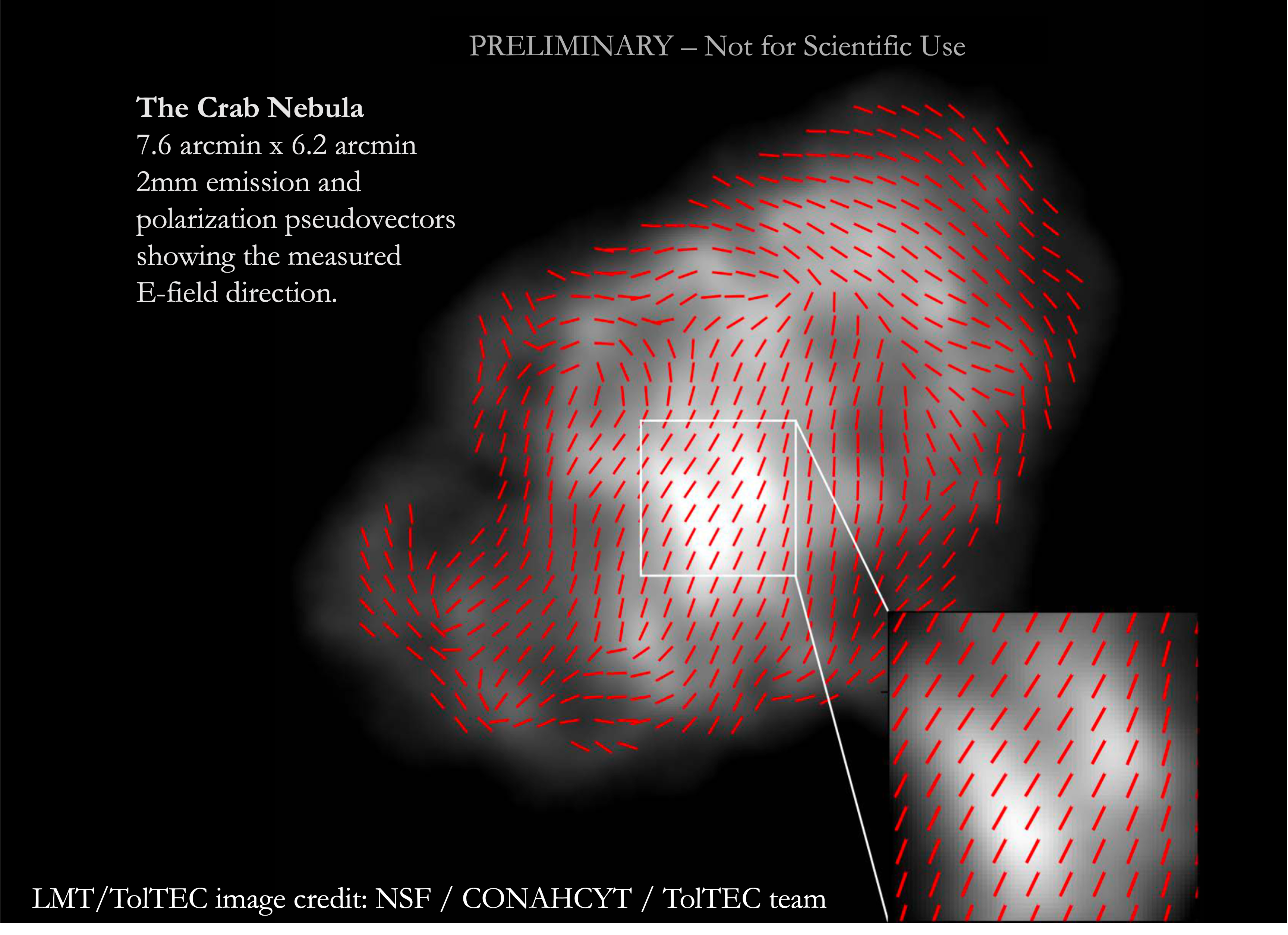
November 3, 2023 It turns out that, at least in our case, doing transformative science requires ... well ... transformers. The LMT has been without continuous electrical power since a massive electrical storm - unprecedented in the telescope's history - damaged the input transformers to the LMT's power station. The LMT Project has been working on getting replacements and we are in a holding pattern (okay, our impatience warrants a much stronger metaphor, but this is a family-friendly news update) as the new transformers are procured. Our team is looking forward to getting back on-sky as the dry cold weather settles in on our mountaintop. My colleagues tell me that it should go without saying that we are electrified for the upcoming commissioning and observing season.
-
[Nb, here are some AI generated puns that didn't make the editorial cut for this update. Be careful out there kids.]
- We're currently experiencing a power nap, but we're amped up to get back to full voltage soon!
- The situation is shocking.
- We're ready to 'conduit' all we can to get things up and running — wiring minds and sparking discoveries.
- While we're waiting to get re-energized, we're not static — we're planning to generate some groundbreaking science.
- Our enthusiasm for the upcoming season isn't alternating — it's direct and strong!
October 30, 2023 Another successful PhD defense. Congratulations to Emily Lunde at ASU who has successfully defended her PhD which was based, in part, on the design and validation of the TolTEC optics. We are all super-proud of Emily and all of our other graduate students.
September 11, 2023 Congratulations to our two newest PhDs in the TolTEC project - Nat DeNigris (UMass) and Samantha Walker (U. Colorado at Boulder). We are all very proud of Nat and Sam and wish them the very best of luck in their new positions. Before finishing, Nat was kind enough to provide this timeline of major events in our project's history.
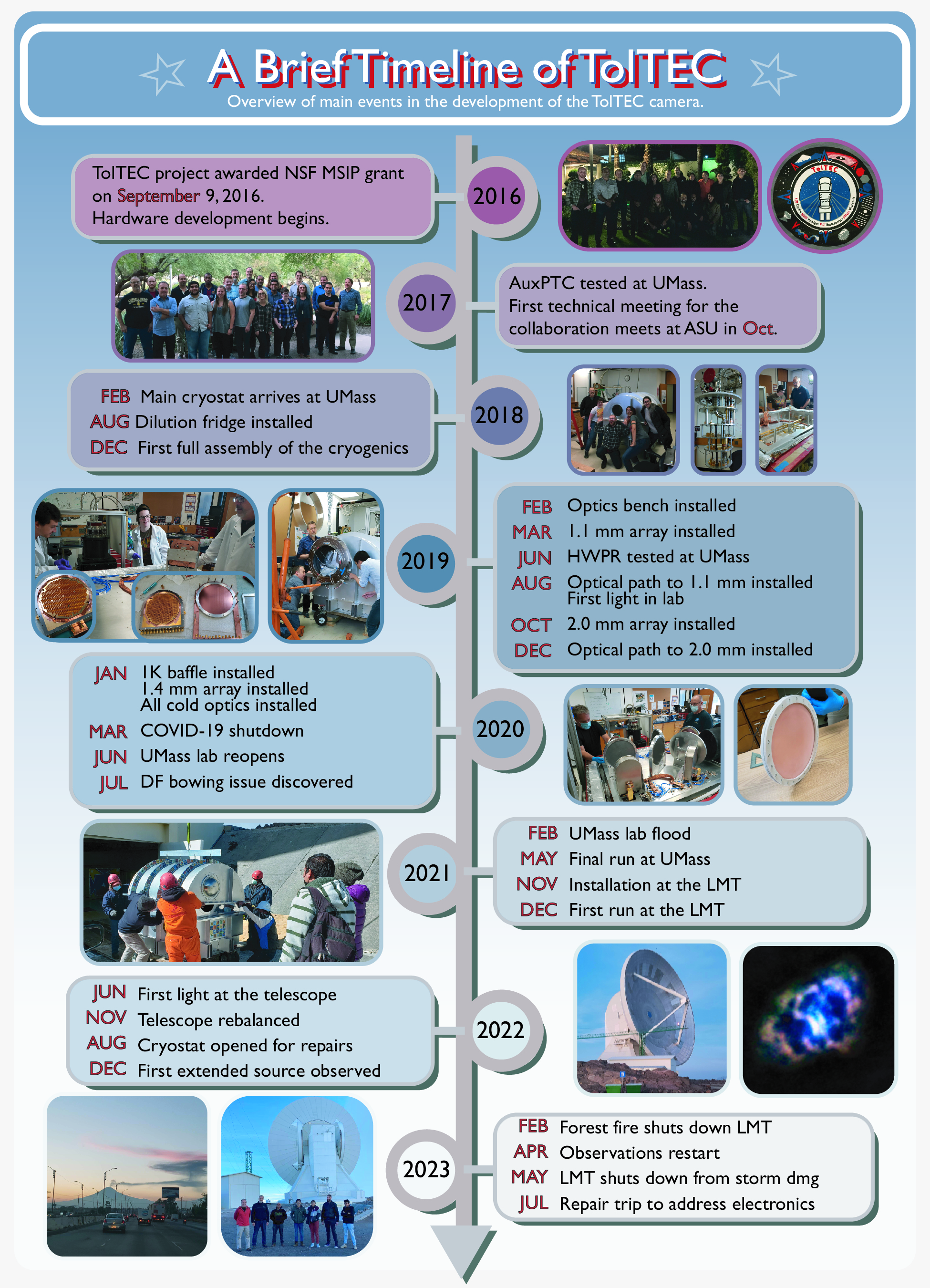
August 25, 2023 The LMT Project has released its call for proposals for the 2024-S1 season. TolTEC proposers should bear in mind that so-far in 2023 we have had only 5.5 nights of on-sky commissioning time at the telescope. Though our team has made enormous progress in characterizing and understanding the instrument since collecting real data in December 2022, we have not had a chance to complete the validation of our operational changes from the lessons learned. The hope is that we will have a significant amount of commissioning time (measured in months rather than days) in the last quarter of 2023 so that the instrument is fully commissioned for the 2024 seasons.
Call for Proposals - 2024-S1 Observing Season.
Dear Colleague:
We are pleased to release the Large Millimeter Telescope (LMT) Call for Proposals for the observing season 2024-S1.
This LMT Call for Proposals offers the opportunity to conduct night-time observations with the LMT in the period 8th January to 30th September 2024. All proposals must be received before the deadline at 06:00 UTC 29th September.
Details, instructions, and resources on how to prepare and submit a scientific proposal to the LMT can be found on the “Proposal Guidance” information page.
If you have any questions about the submission process, or the information provided, please contact the LMT Help Desk.
Sincerely,
David H. Hughes, LMT Director and LMT Mexico Principal Investigator
F. Peter Schloerb, LMT US Principal Investigator
August 18, 2023 2023 has not been kind to the LMT or to our efforts to get more commissioning data with TolTEC. Here is an announcement from the LMT Project Office regarding our latest power travails and the upcoming call for proposals.
Suspended LMT observations and delay to the release of the next Call for Scientific Proposals for the LMT 2024-S1 observing season.
The electrical power sub-station of the LMT has suffered from the impact of unusually-strong seasonal electrical-storms and lightning strikes that have damaged both the transformers at the LMT site and the CFE electrical grid supplying electrical power to the site.
Given the uncertainty in the schedule to replace the damaged infrastructure and equipment, and to fully restore electrical power to the LMT, we have been forced to postpone the release of the next call for LMT scientific proposals and delay the start of the new observing season until January 2024.
We are exploring the possibility to temporarily operate the LMT for a continuous extended period using electrical power provided by our emergency-power diesel generators whilst waiting for the repair to the LMT electrical sub-station to be completed. Over the next few months (September – December 2023), and once a stable source of electrical power is restored to the site (using the emergency generators or the CFE electrical grid), the LMT engineering teams will begin a series of activities to improve the performance of the 50-m diameter primary reflector including photogrammetry measurements, the installation of a small number of upgraded primary surface-segments and installation of an expanded network of temperature sensors within the telescope structure.
Simultaneously the LMT scientific instruments will be cooled down, tested and made available to continue the approved 2023-S1 scientific program as soon as possible. The commissioning of the TolTEC instrument will also resume with the testing and performance characterization of the different TolTEC mapping-modes. The highest-priority A-ranked proposals (including those requesting TolTEC) from the 2023-S1 season that cannot be completed or attempted before the end of the year will automatically be carried over to the 2024 observing program.
Further details on the schedule for LMT observing opportunities during the remainder of the year, and the release of the next Call for Proposals to conduct a new scientific observing program in 2024, will be announced shortly. The first of a short series of LMT webinars, to provide more information on the LMT scientific and engineering activities throughout the remainder of 2023 and beyond, is scheduled to take place on September 6th 2023 at 15:00 UTC. Instructions on how to join and participate in this LMT webinar series will be made available via email and also described on the LMT webpage (www.lmtgtm.org).
David H. Hughes
LMT Director, LMT Mexican Principal InvestigatorF. Peter Schloerb
LMT US Principal Investigator
March 8, 2023 Well, it's been a mixed 2023 so far. The TolTEC team is making really nice progress on our data analysis from the short commissioning run we had. It's just amazing how much you can learn from a few nights of nice data and so we are very fortunate that we have it in the can. On the flip-side, we have had a string of bad luck that has prevented us from collecting any additional data since then. A power outage at the telescope took down a key pump in our dilution fridge and though we quickly brought in a new one and got it replaced, the system warmed up and required a new cooling. Just as we got cold again, a forest fire broke out on Siera Negra and shut down operations. You can read about our recovery from the forest fire in this notice from the LMT Project.
On the analysis side we have teams working on the PSF characterization, polarization analysis, calibration, and, of course, mapmaking. Our strategy of hosting multiple mapmakers (both naive and maximum likelihood mapmakers) seems to be really paying off with different insights coming from both approaches. A future note will go into more detail on these and also highlight the great work some of our team members are making on the software side.
January 23, 2023 TolTEC achieved a major milestone in late December 2022 by collecting some comissioning data on bright objects. We have been working hard to analyze and understand the commissioning data we took during a two-week stretch right before Christmas. While the data is still a ways from being science quality and we cannot yet give a definitive answer on key issues such as mapping speed, TolTEC has produced some beautiful images we would like to share with you.
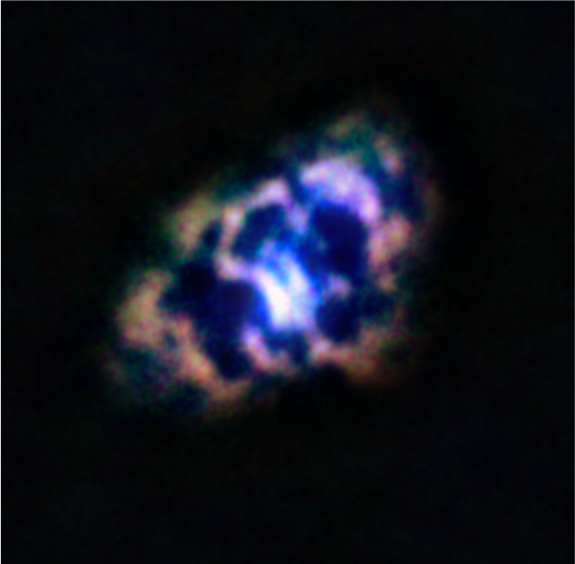
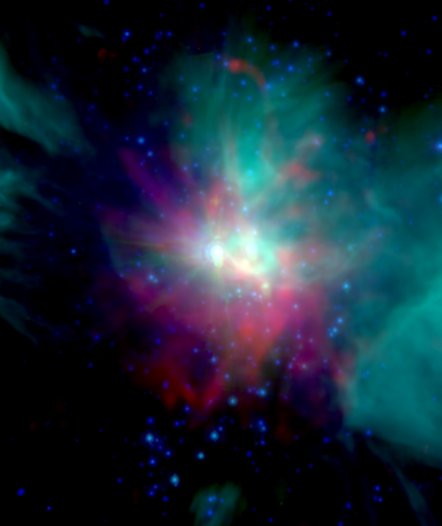
Commissioning will recommence in early 2023 to fully characterize the camera's mapping modes and start the scientific data campaign. In the meantime ...
October 12, 2022 Passband data has been posted to our Dataverse installation. Be warned that 1) these are measurements from the lab (though we have a team at the site as I write this who we hope will get some new FTS measurements done this week) and 2) the posted curves are representative of the passband data for each detector network. If your TolTEC project relies in detail (say, at the few % level) on the details of the passbands, then reach out to the LMT Helpdesk to see if they can help you.
September 26, 2022 The LMT has released the Call for Proposals for 2023-S1. This is the first call that includes TolTEC. We are supporting the instrument in "shared risk" mode, which really means that proposers should understand a few things: (1) We've only had 8 nights of LMT time during the summer to check things out and learn how to use the camera, (2) our mapping speed estimates are very uncertain still, and (3) we can't really guarantee anything until we get to use the camera a lot more. That said, we are super-excited to get started with it and offer it to users from around the world.
Those interested in proposing TolTEC observations will want to use the TolTEC Observation Planner to make an estimate of the required observing time. The ObsPlanner is currently set up with our best understanding of the instrument performance. But of course this is evolving over time as we implement improvements and continue to estimate the sensitivities we measured in July 2022. All this to say, the model behind the planner is sophisticated, but so far the data constraining the model is still weak by comparison. Our hope is to provide a conservative estimate of the observing times required to do a particular project. But we encourage users to be judicious in their padding of the requested observing times in their proposals.
For those interested in a more general description of how TolTEC will be used as a camera on the telescope, take a look at the Using TolTEC page on this website. This describes some of our observing modes as well as some of the overhead considerations.
One more note about the availability of TolTEC in the coming observing season. Since we do consider these projects "risky" for all the reasons noted above, we are limiting each proposed observaton to a maximum duration of 5-hours. This may seem short, but TolTEC is a powerful camera and so we are certain that even with this restriction there will be many exciting science projects.
September 12, 2022 In another blink of an eye the summer has ended and we are all back to balancing teaching, classes, and research. For the TolTEC team, the summer was capped off with a trip by a few of us to the telescope to open up the cryostat and do a bit of editing inside. There is good news and there is good news. The good news is that, with the help of the amazing site crew at the LMT, we came up with a scheme to safely open the cryostat and do all of our internal work
The other good news is that we were able to diagnose and rectify problems with detector networks 5, 6, 7, and 12. We are hopeful that our changes in each of these systems will dramatically improve their performance.
The fall is now looking pretty exciting. The LMT has reserved time for TolTEC commissioning for as soon as the atmosphere dries up. The camera, as of today, is just entering the last phases of the cooldown and so we should have a good idea of where we stand by early next week. As soon as we are on-sky and checked out, we will get going on the commissioning projects that have been on the books for a long time. After that it is on to the first phase of the Public Legacy Surveys. In short, there is an enormous amount for us to still do but we are eagerly looking forward to getting going with the LMT.
July 7, 2022 Our last night of observing on the LMT until September. Since getting going we have battled wet weather and some nights of fairly crummy observing conditions (compared to winter months) to get a total of 8 on-sky nights with TolTEC on the telescope. We have shown that we can make maps of sources in the sky, focus and correct the telescope's astigmatism deformation (due to thermal gradients in the big dish). Overall, we have 74% of the detectors working in the 1.1mm array, 26% in the 1.4mm array, and 53% in the 2mm array. All of these yields will be improved in the future but we ran out of time in this run. The measured detector positions in the three arrays are shown here:

June 23, 2022 Looking through the LMT we see Saturn! Okay, so Saturn is terribly bright at mm-wavelengths but this is the first astronomical source that we detect with TolTEC. There was a lot of work to do to align the warm optics (we're not quite done with that yet) and get the detectors tuned up. But once we turned the telescope to our ringed neighbor, there it was. We then went on to make some nice beammaps of Neptune. Onward and outward into the universe from here...
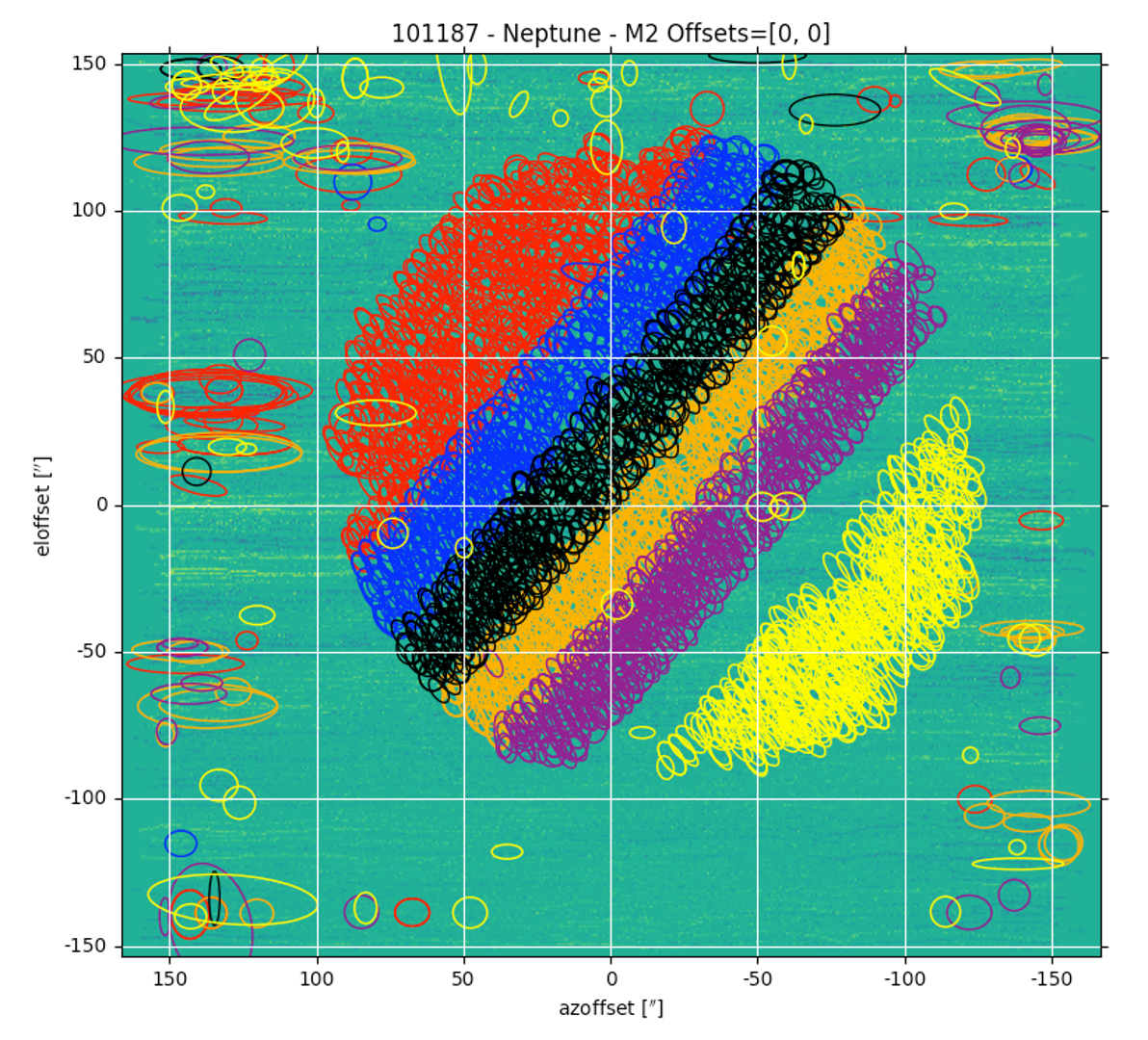
June 6, 2022 What a busy last 4 months for the TolTEC team. Here are the bullets points. From February to June (!) we struggled with a cryogenic problem that was honestly just baffling. All of the evidence was pointing us in one direction, and the problem ended up being somewhere totally different. Kudos to the team for sticking at it and for enduring many trips to the site and the long cooldown cycles. Cryogenic systems are difficult in the best cases. Cryogenics in very large systems (where the whole field of astronomy is heading) is so much harder. That said, we got he problem licked and finally have cold detectors to get working on.
February 7, 2022 Well, January was a difficult month for the project. We got a double-dose of delay due to the Omicron variant surge, first in the US and then in Mexico, along with a hardware problem with the TolTEC dilution refrigerator that we discovered during our first cool-down attempt. Fortunately, as of today we now have a small team of UMass people at the site working on the dilution frige. They have the replacement parts and we hope that the swap can be made within the week. More to come ...
December 28, 2021 Where did the past month go? After a long sprint of reassembling the main cryostat, installing the dilution refrigerator, building up the AuxPTC, and clearing the way in the LMT's receiver cabin, TolTEC was installed and primed for its first cool down when the last of us left the site on December 18th. Given that the telescope will be left vacant until early in the new year, we're going to let TolTEC sit idle until January 3rd, when we'll turn the refrigerators on and let it start cooling.
All in all, 2021 was a great year for our project. We solved a vexing optical problem, did our final tests of the instrument hardware at UMass, and pack and then unpacked and installed the full system at the LMT. Several of our team members really stepped up and shone throughout this process. We're lucky to have them.
Happy New Year to everyone. We can't wait to see what new science 2022 brings!
November 28, 2021 It was TolTEC shirt day at the telescope today and so we took a moment to pose for this muscle shot. (Clearly, this is not a team that should be messed with). From left to right: Steve Kuczarski, Grant Wilson, Emily Lunde, Nat DeNigris, Emmaly Aguilar, Itziar Aretxaga, and Scott McElhinney. Kudos to Sophia Wilson and Emily Martsen who collaborated on the design and implementation of the mural in the background.
November 21, 2021 Equipment continues to be delivered to the site and we are splitting our time between unpacking, checking out the hardware (it is a very rough ride up the mountain!), and starting to reassemble the camera. We've got a great crew and that's especially important since we have to be extremely carefull working at 15,000 feet altitude where, well, you don't think nearly as well as you do at sea level. Delicate work is very challenging - so we give it to Nat. All in all, the days are shortish in terms of the number of hours at the site but still we get back to the hotel completely exhausted.
November 19, 2021 The first wave of the installation team arrived at the telescope today.. The crates are just behind us with the first few scheduled to show up tomorrow. Despite that, we had plenty to do as we got acclimated, started setting up our work areas, and took a long tour of the telescope. It was a great feeling to be back.
November 5, 2021 Another step forward. Yesterday UPS delivered the 20 TolTEC crates to INAOE. We have heard that the INAOE Administration is taking steps to have the mountain access road graded and is planning to have the TolTEC equipment delivered to the telescope by November 15. As you can imagine, a bunch of instrument team members are now scrambling to get ready to join the equipment that same week. As one of our colleagues at INAOE said, TolTEC is oe step closer to the top of Sierra Negra.
November 2, 2021 Happy Dia de Muertos everyone. Today's holiday brings the great news that the TolTEC equipment has cleared customs at Mexico City Airport. Soon the equipment will be delivered to INAOE as a last stop before heading up to the telescope to meet the installation team.
October 15, 2021 At long last, UPS is on its way to pick up the TolTEC shipment from UMass on Tuesday, October 18th and bring it to INAOE. During the adminsitrative delay our colleagues at Northwestern University finished up their work on the half-wave plate rotator, a critical piece of hardware for making high sensitivity polarimetry maps, and we've added that equipment to the shipment to make it an even 20 crates of goods. Once the equipment reaches INAOE, our colleagues there will arrange for a special, air-bearing equipped, LMT truck to ferry the packages up to the telescope. An installation team will then head to the site to start the long (3 week?) process of reassembling the radiometer. It's going to be an exciting November if all goes well.
August 23, 2021 When are we going to install TolTEC at the LMT? ... is a commonly asked question around UMass. Well, the instrument is all packed up and awaiting the last of the paperwork to be filled out by our colleagues in Mexico so that it can be shipped. Once it arrives at the telescope, the timeline will be determined by our need to ensure the safety of the team that will be doing the installation. Our biggest concern at the moment continues to be the pandemic, which as everyone knows is extremely difficult to predict. (I watch the New York Times tracking page regularly and continue to hope for the best for everyone affected.) We all feel enormous pressure and incentive in pushing the schedule along, but we must keep safety as our first priority. So all I can say at the moment is ... stay tuned.
August 16, 2021 Here's a quick shout-out to three amazing undergraduates who did summer internships in the lab at UMass in 2021. Shown below from left to right are Caleigh Ryan (UMass class of 2022), Jack Slater (William and Mary class of 2022), Nat DeNigris (not an intern) and Emily Martsen (UMass class of 2022).
Over this past summer, Caleigh, Jack and Emily worked tirelessly on both TolTEC hardware and science projects. We had lectures on observation planning, cryogenics, detectors, detector readouts, galaxy cluster physics, interstellar dust ... and the proper way to drive a wood screw into a crate. It was an eclective and intensive experience. All three of these young scientists took on every day's activities with aplomb and an eagerness to learn. What a pleasure it was to work with them. This extends our amazing run of luck at attracting great people to our project. Caleigh and Emily will continue working on TolTEC science through their UMass Honors College Senior Thesis Projects. Jack has returned to William and Mary but plans to do what he can remotely as he completes his degree in engineering physics.
August 13, 2021 Hey, remember back in May when I wrote that we would update the News section of this website more often? ... whoops. Well, we haven't been twiddling our thumbs. After wrapping up a long round of testing in May, over the summer an amazing group of interns and budding scientists took a deep dive into TolTEC - first doing noise testing and new kinds of noise characterizations, and then completely disassembling the full system and crating it up for shipping. This was a HUGE process and we ended up with 17 crates of hardware.
We are working on the (hopefully) last bits of the administrative parts of the shipment. Once that's done, UPS will come and pick the instrument up and off to Mexico it goes. A team from UMass, Northwestern, and ASU will follow soon after it arrives (modulo delays caused by the pandemic) and we'll get to work on the installation. These are exciting times!
May 5, 2021 Well this is embarassing. We have been so hard at work on TolTEC during the past year and a half that we haven't been updating the 'news' portion of our website regularly. We're going to try to change that ... starting now with a few big announcements.
First, if you've been keeping up with the TolTEC progress, you might have been aware that we were suffering from an optics issue that was inducing a bad mis-focus of two of our arrays. Well no more. This past weekend we made our first measurements of the corrected optical system in the lab at UMass and it's looking great. Here are a set of in-lab beam maps showing the three arrays in their glory.
Second, keep a safe distance from all UPS freight trucks for the next few days. Our first shipment of TolTEC parts has just left UMass for Mexico. This shipment contains infrastructure pieces for our optics, the main cryostat, and our compressor coolers. Getting the crates out the door and on the truck is a major milestone for the project and the shipment will serve as a pathfinder for shipping the rest of the system.
And finally, I'm very pleased to announce that we are in the process of making a lot of our software that we've developed for the camera publicly available for the first time. We've generated a lot of specialized tools for working with KID detectors. Zhiyuan Ma and Kamal Souccar, who lead this effort, have developed a software suite that other experiements can benefit from. Head on over to our GitHub site to check it out.
December 17, 2019 - The integration and testing has been fast an furious over the fall and time flies. I'll be posting a more significant update in the next few days, but in the meantime, here is a nice image of the TolTEC optics bench during our testing in early December. The 2mm array is in the center of the image near the bottom and the 1.1mm array is in the upper right. Both look through thier respective optics and then through a small hole in the blackend structure in the lower right (the lyot stop). This is aligned with the TolTEC window (not shown). During testing we send known optical signals in through this peep hole and monitor the detectors' responses. Missing from this picture is the 1.4mm detector array ... more on that in my next post.
September 20, 2019 - Well, that summer went by fast. As far as TolTEC goes it's been intense, fun, and full of new milestones. Rather than spell out all our adventures, here is a quick update that just went out on our email list (check out the Get Involved page if you haven't signed up yet).
Here's a quick note about the status of TolTEC and what our plans are in the upcoming few months. We are now starting a big sprint towards shipping TolTEC to the LMT in December with a plan to get installed on the telescope and commissioning well underway in January of 2020. We've just had a big summer of intensive testing of the system with several new milestones. Here are some highlights:
I hope everyone is enjoying the start of fall and looking forward to new TolTEC data in 2020.
June 4, 2019 - The team is gearing up for our first cooldown of the full 1.1mm KID array of 4012 detectors inside TolTEC at UMass. The array has been previously tested at NIST and this will be the first run in the actual camera. To get there we need lots of parts to come together this week. Below is Justin Mathewson at ASU putting the finishing touches on custom-made stainless steel coax that will carry the detector signals. Underneath are coaxial cables ready to be packaged up and shipped to UMass. Overall ASU has put together approximately 122 different hand-made cables.
May 16, 2019 - Okay, I admit that I've been horrible about updating this webpage, but that's only because we've been so busy putting TolTEC together in the last 5 months. Some of the milestones we have celebrated include:
May 11, 2019 - Congratulations to several graduates from the TolTEC team! Reid Contente, Miranda Eiben, and Amy Ralston all received their B.S. degrees from UMass today. Reid will continue with the TolTEC project here at UMass while Miranda will move on to Harvard for graduate school in Astronomy and Amy will go to U.C. Irvine for Physics. Congrats to all three!
We have milestones at ASU as well. Dr. Sam Gordon defended his thesis on KID readout electronics and Adrian Sinclair passed his graduate qualification exams.
December 23, 2018 - After a massive push in the past few weeks we've just started the first full cryogenic cooldown of the entire TolTEC cryo system. Some photos of the assembly of the cryostat are now posted on the Photo Gallery page.
October 25-26, 2018 - To cap off a very busy week for the team, we held a workshop for the definition of the Extragalactic Legacy Survey Projects at UMass. We had 83 scientists come together to discuss potential survey fields, strategies, and complementary data sets. It was a very rich event and the excitement over the new capability of the camera was palpable. After the working group goes over the field selections one more time we will post the results on this website.
Many thanks to everyone who participated!
October 24, 2018 - The TolTEC Project hosted Rich Barvainis and Peter Kurczynski at UMass for an NSF Site Visit Review today. Overall the visit went very well. The highlight was a series of talks by 10 of the junior team members from UMass and ASU. They did a terrific job and represented the project well above all expectations.
October 23, 2018 - We've just had our 3rd Team-wide face-to-face meeting for the techncal team. Progress on all fronts looks great and we did not identify any issues that should keep us from getting to the LMT in 2019. Overall, about 30 team members joined in person or remotely at the beautiful fall UMass campus to review the status of the project and make plans for the coming year.
September 26, 2018 - Reid Contente, an undergraduate researcher at UMass and musician has put together a new song inspired by his work in the lab. According to Reid: This is a hip-hop influenced track made from audio recordings of the sounds we hear in the CDL lab every day. The sounds of compressors, turbo pumps, and pressure release valves were recorded on my LG V30 smartphone over the course of two days. In this time we had finished preparing the Oxford dilution refrigerator for its first cool down; first by pulling a vacuum on the outer vacuum chamber and all the lines, then charging the system with the helium mixture, finally running the helium compressors and pumps. I recorded the audio from equipment that make percussive sounds in order to use the samples in essentially one big drum kit. With my piano keyboard and MPC sample pads I was able to freestyle a beat, starting with the loudest and biggest sound recordings and adding the other samples that worked with the groove. Finally with a few choice audio effects and some mixing and balancing we have this track made entirely from the sounds of our science.
September 5, 2018 - here are some new pictures of the gold plated feedhorns for the 1.1mm array and a closeup of the corresponding feedhorn array.
August 8, 2018 - NIST has completed the full fabrication of our 1.1mm array of detectors. Check out our Photo Gallery for a few pictures of the new array. Jason Austermann is preparing to test these detectors now.
July 23, 2018 - We've just hit a major milestone in the project. Our new Oxford Instruments dilution fridge, which was installed in the lab at UMass during the past 2 weeks, hit its base temperature over the weekend. Our acceptance tests are ongoing but preliminary results show that we'll have at least 450uW of cooling power at 100mK. Our thermal model predicts that we will need less than 150uW of cooling power to cool the TolTEC detector arrays to their operating temperature so we should have plenty of extra capacity with this system to tackle unexpected heat loads. Pictures will be posted to the gallary page soon!
July 20, 2018 - Here's a new photo of the 1.1mm array's feedhorn assembly from NIST prior to gold plating. This is a stack of more than 50 silicon wafers that are each individually cut in order to generate the proper feedhorn profile. The resultant "corrugations" provide good symmetry in the acceptance of the two polarizations. Overall NIST was able to pack 2003 feedhorns onto the structure - that's 4006 detectors if we put one behind every horn so we may get to up our detector counts as we push forward.
June 20, 2018 - The registration page for the TolTEC Extragalactic Workshop to be held on October 25-26, 2018 has just gone live. We're looking forward to a beautiful fall meeting that comes on the heels of an open CANDELS meeting. We hope to see everyone there to help choose the best fields and depths for the two extragalactic legacy surveys. Come for the fall colors, stay for the dusty galaxies!
June 20, 2018 - Where have the last 5 months gone? Well, no news is pretty much good news here. So much has been happening as we integrate the TolTEC cryogenics at UMass, build detector arrays and feedhorns at NIST, put the finishing touches on optics and detector readouts at ASU, and finalize detailed designs of the half wave plate rotator at Northwestern. Here are some highlights:
- Check out the Galery page of this website for some recent pictures of folks at the UMass lab at work.
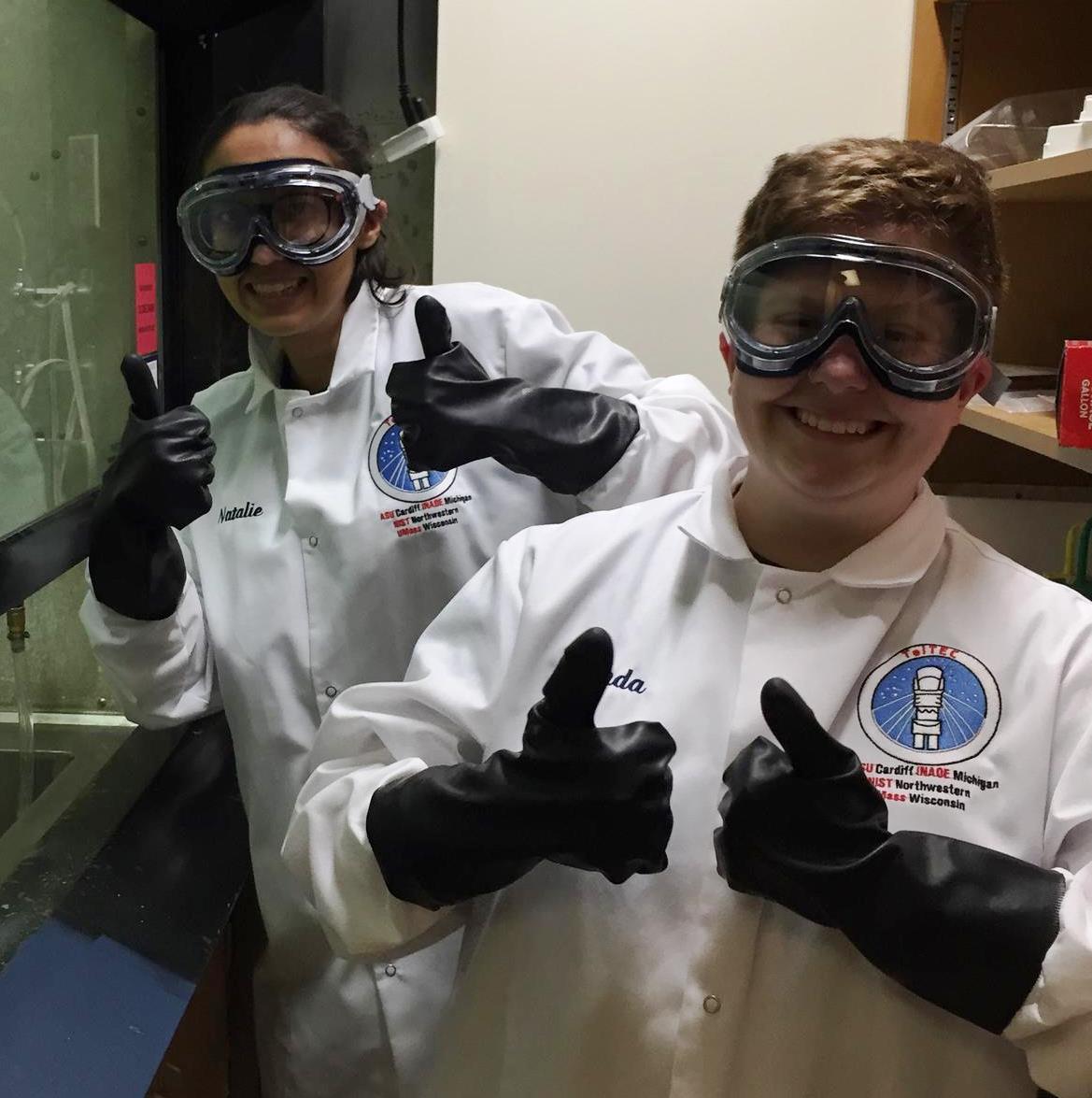
- We've hired a TolTEC postdoc at UMass! His name is Dr. Zhiyuan Ma. Zhiyuan is a recent graduate of the University of Missouri where he worked on the optical counterpart identification of sources found in Herschel surveys. We're real happy to have Zhiyuan as part of the team.

- TolTEC had a good presence at the recent SPIE meeting in Austin, Texas. Talks were given by Jason Austermann, Sean Bryan, and Grant Wilson. Be on the lookout for the corresponding papers on Astro-ph.
January 27, 2018 - Happy New Year everyone. There's been so much going on that I haven't had time to keep the news reports flowing. Here's a quick update:
- The TolTEC cryostat is being built by Atlas Technologies. We are now expecting delivery at UMass sometime in February!
- Our TolTEC dilution fridge, being built by Oxford Instruments, is coming along and is now promised for delivery to UMass in early May.
- We have a new postdoc ad out at the AAS register. Due date for applications if Feb. 10, 2018
- And finally, check out the "Meet a TolTEC" entries on our TolTEC Facebook page. We've currently got a few UMass people posted but we should be adding team members from other instituions soon.
October 24, 2017 - We've just had our 2nd Team-wide face-to-face meeting for the instrument team. Overall more than 30 scientists joined in person or remotely at ASU to review the status of the project and make plans for the coming year.
August 31, 2017 - The TolTEC Science Team has ratified the rules by which astronomers may have access to TolTEC data prior to the public data release. See: TolTEC Data Access and Science Exploitation Policies
May 30, 2017 - TolTEC Project Scientist Itziar Aretxaga of INAOE was just awarded a "Fronteras de la Ciencia" grant by CONACYT in Mexico for her proposal "Deep panoramic surveys of the sky at 1.1/1.4/2.1mm with the new polarimetric camera TolTEC". Congratulations Itziar and Co-Is!
March 7, 2017 - NIST has produced its first round of prototype detectors for TolTEC's 1.1mm array.
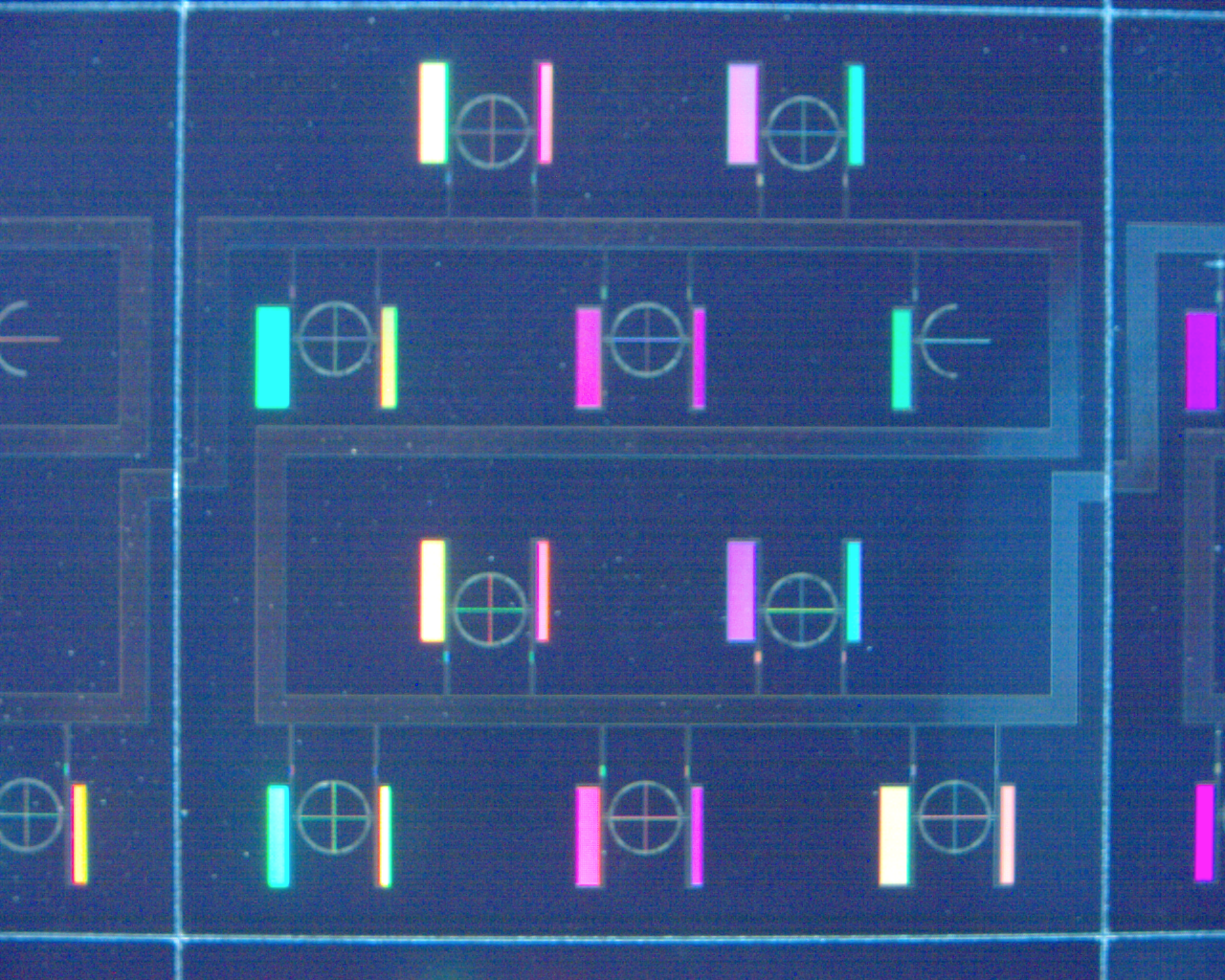
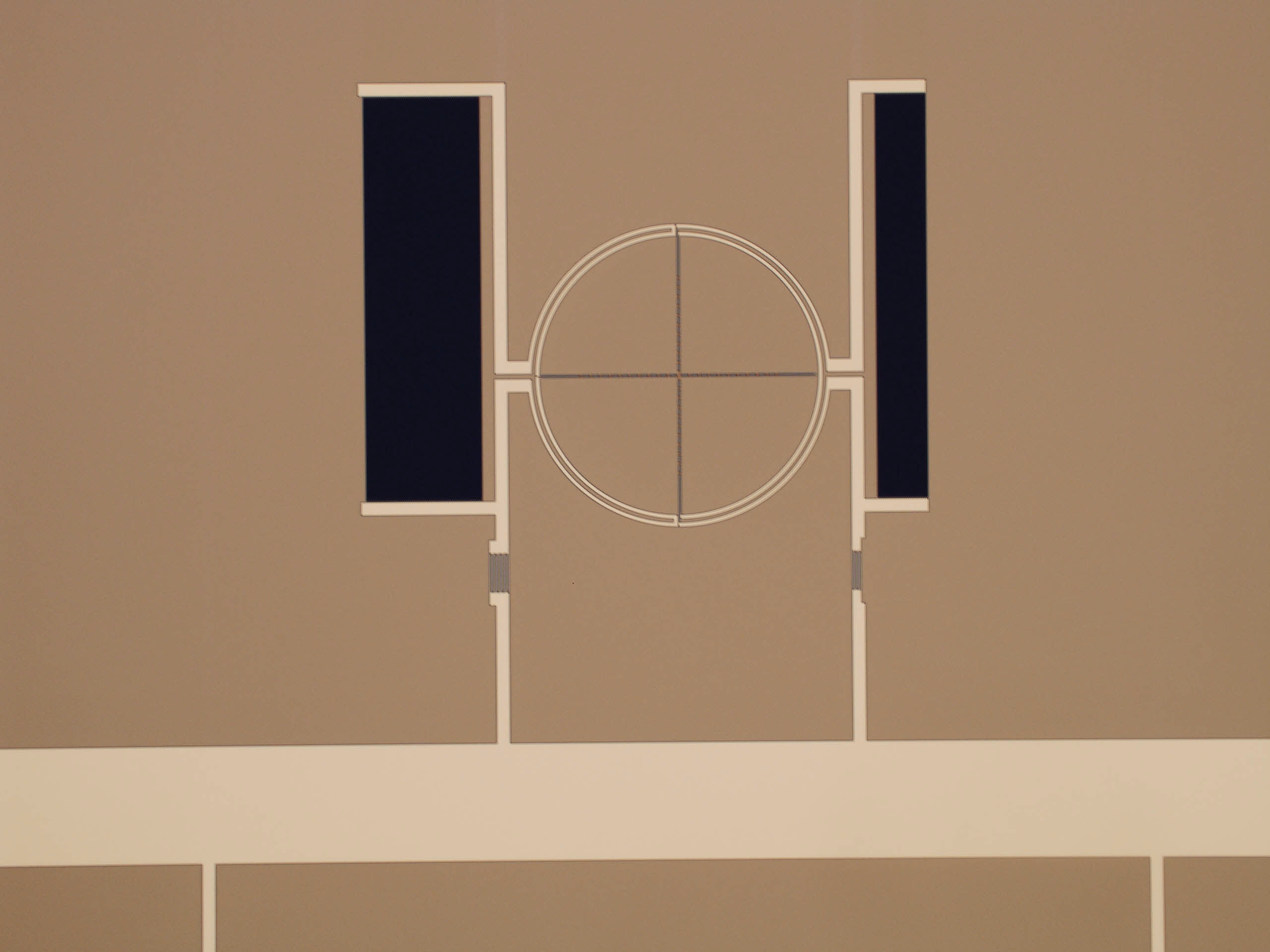
February 2, 2017 - Word came today that NVIDIA has generously donated a Titan X Pascal GPU to the UMass TolTEC group to support the development of the TolTEC analysis pipeline. We are currently investigating the benefits of moving the analysis pipeline from a CPU-based approach to a GPU-based approach. This donation will allow some of our students to get to work on a much more powerful GPU than we currently have in the lab. Many thanks to the NVIDIA GPU Grant Program.
February 1, 2017 - TolTEC is going to be big! The UMass undergraduate team working on TolTEC built a model of the footprint of the instrument and then got inside. It's a little intimidating that we all fit with lots of room to spare.
January 12, 2017 - The first major piece of TolTEC equipment has arrived at UMass - our PT415 Cryomech pulse tube cooler. We're looking forward to getting this installed in a new small Precision Cryogenics vacuum can that arrive in a few months.
December 15, 2016 - Come visit with some of the TolTEC team at the AAS meeting in Grapevine, Texas. We are having a session for people to hear about results from LMT early science and a discussion about the TolTEC surveys. Here's a flyer for the event.
December 1, 2016 - We have posted our add for a postdoc to work on TolTEC to the AAS job registry. Please let interested candidates know. This is a great opportunity to work on a fast-paced and exciting project.
October 19, 2016 - Check out the three versions of the TolTEC Project press releases: UMass, ASU, INAOE/Mexico (in Spanish!)
October 16, 2016 - We have finally downselected our logo from a bunch of great submissions. Thanks to Sean and Sam for the winning entry that includes both a nod to TolTEC culture as well as a radio telescope.
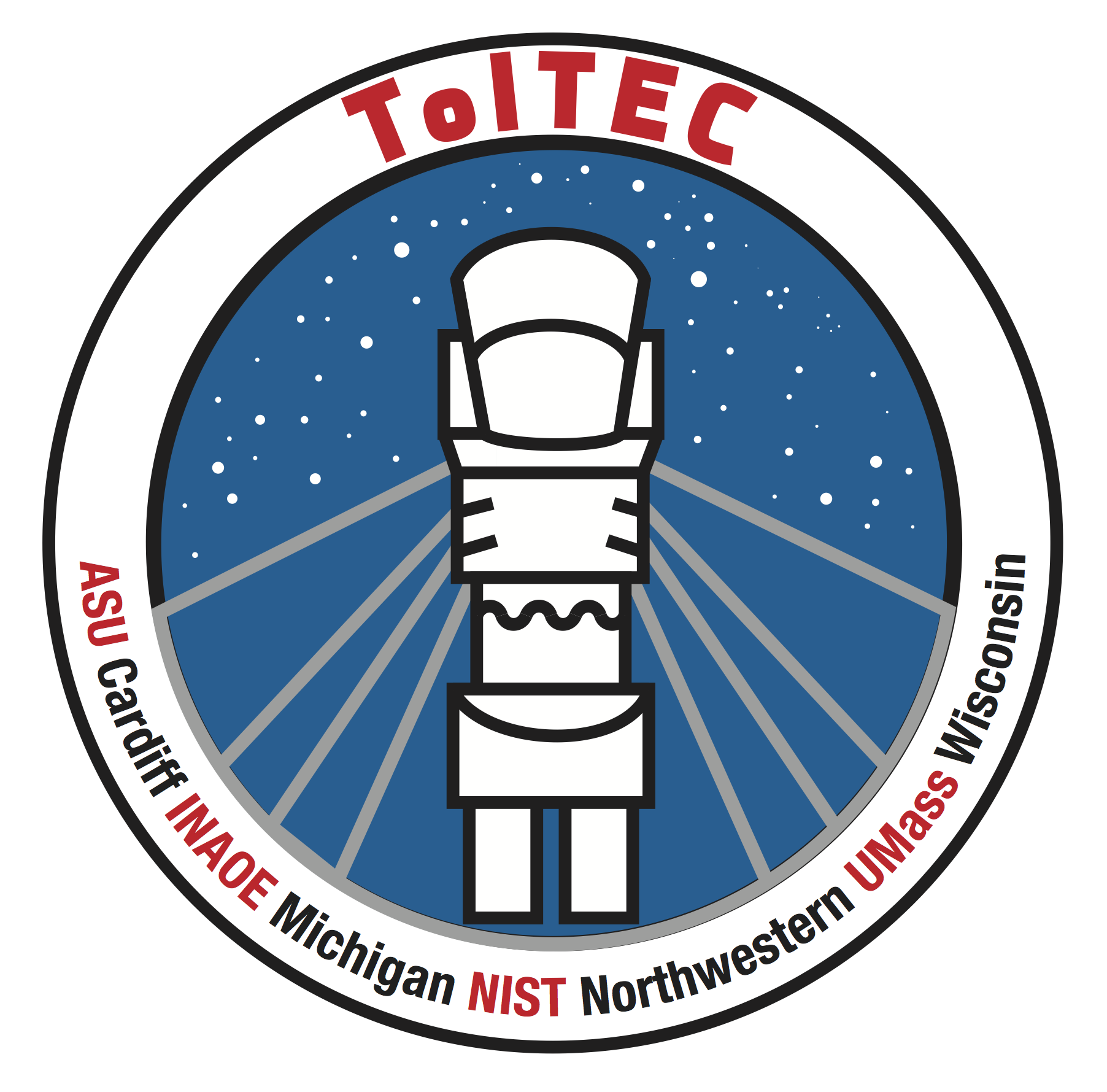
September 28, 2016 - GW - We have just completed our project-wide, two-day technical Kickoff meeting. The meeting was held at INAOE in Mexico at the LMT Project office. Most subsystems have passed PDR and the technical team is now off to the races in detailed subsystem designs. We also have had our science team kickoff meeting with over 40 people in attendance. Everyone is encouraged to sign up for our email news letters on the Get Involved section of this website.
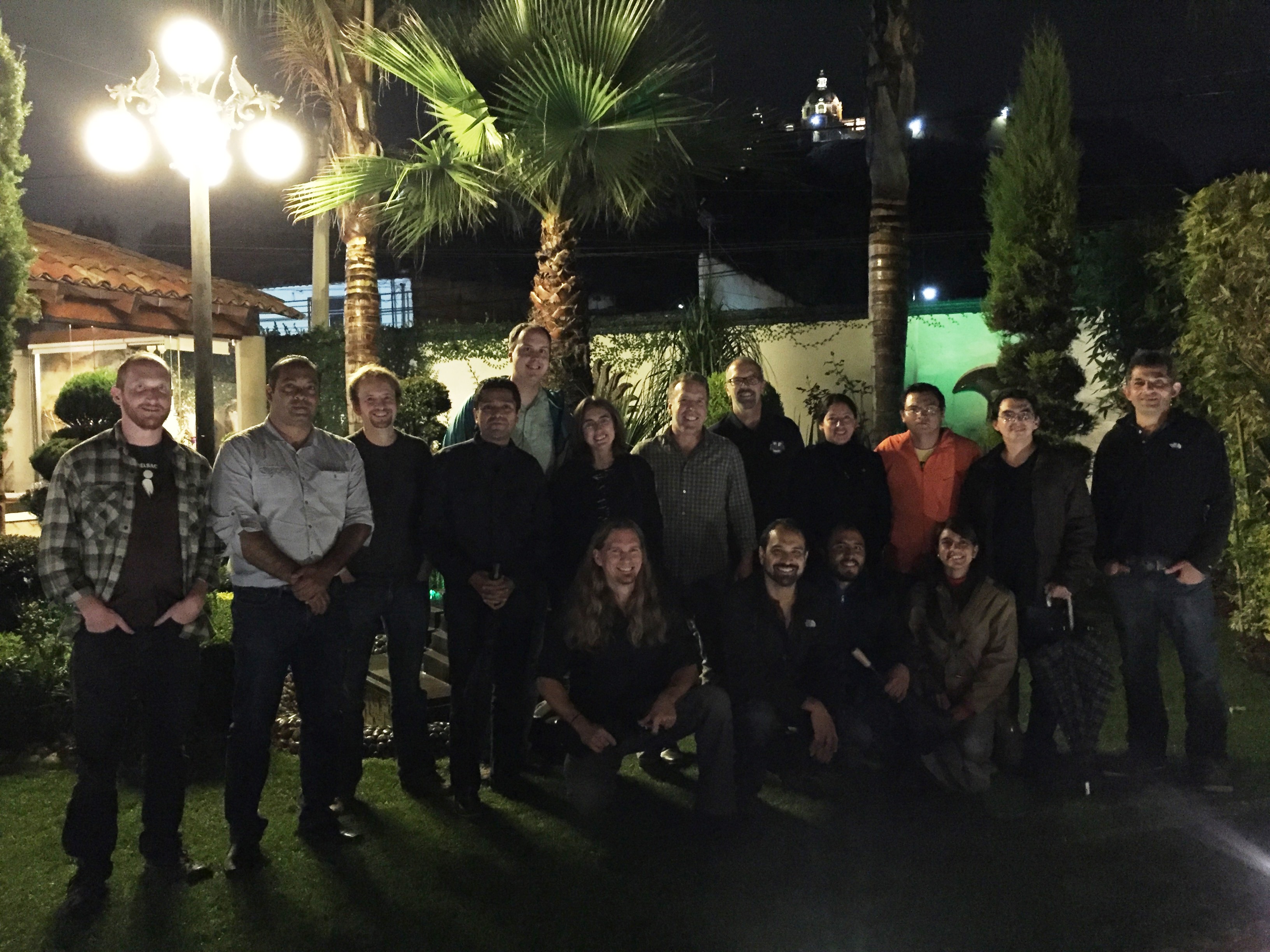
September 9, 2016 - GW - It is finally official, TolTEC has been funded by the NSF.
October 16, 2015 - GW - We've got a project public website.
